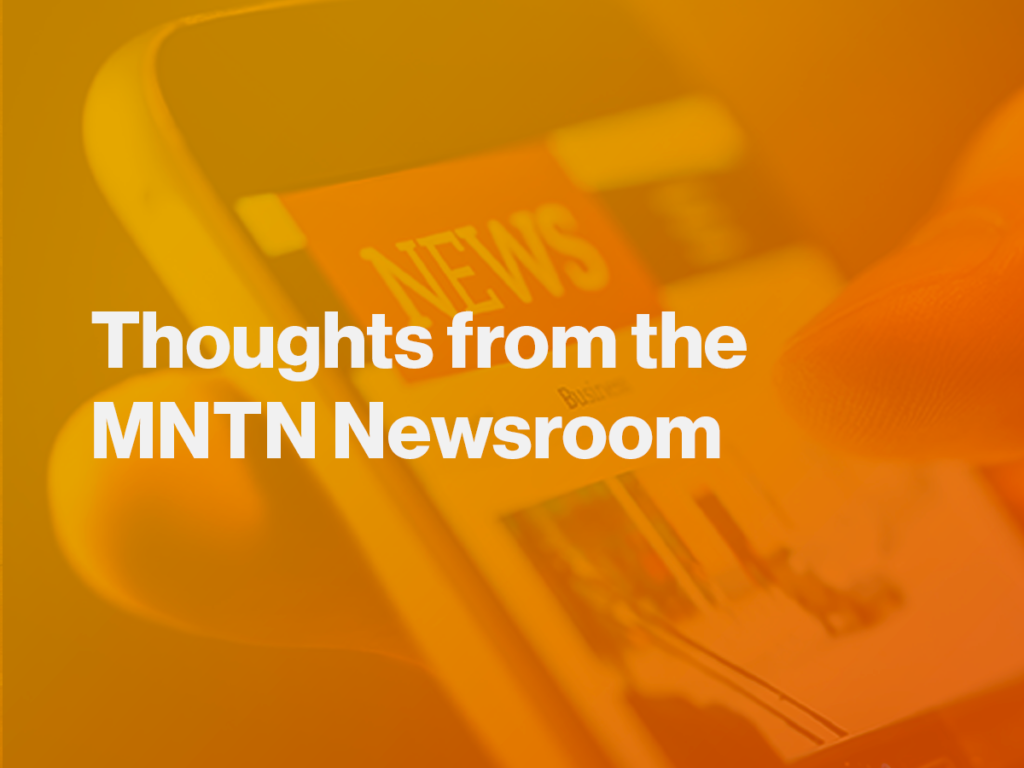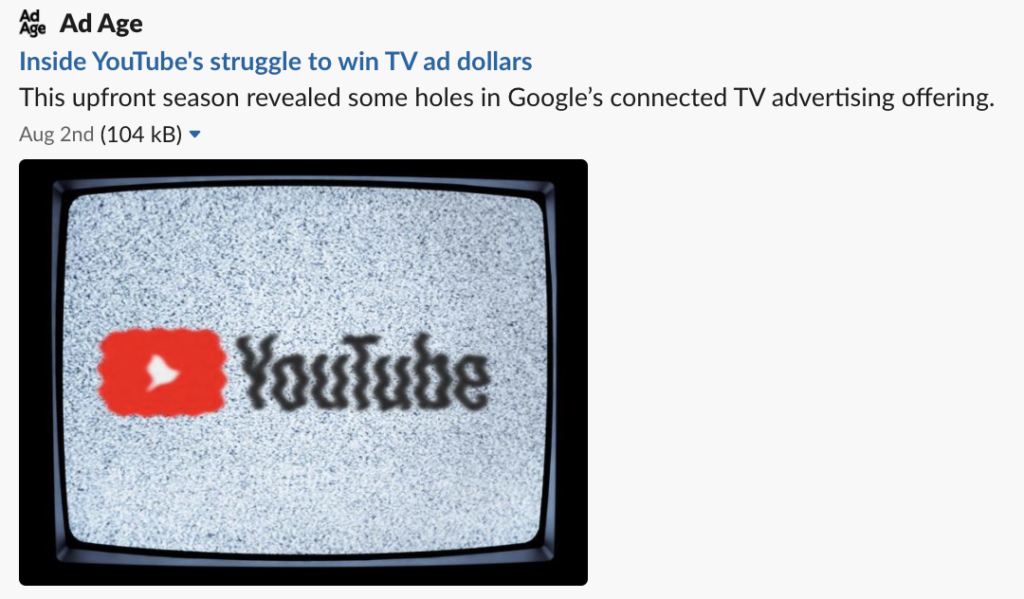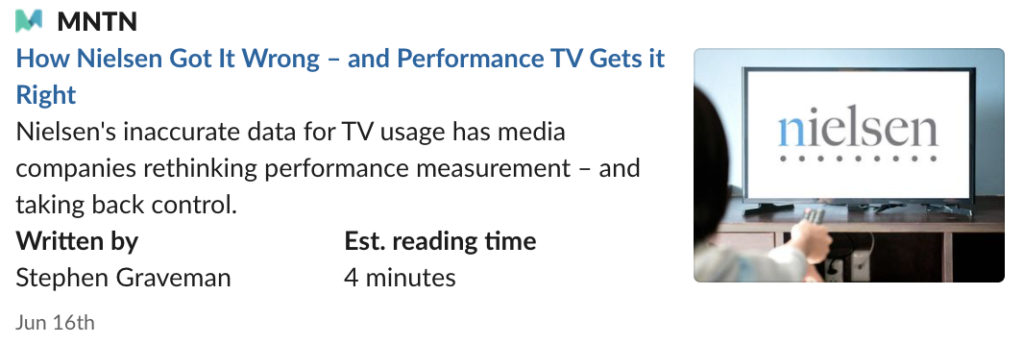Blast From the Past: Streaming is Reviving the TV of Old
by Frankie Karrer
4 Min Read
CES 2024: Stagwell (STGW) and MNTN Announce Partnership in Unified Performance SolutionsLearn More
Can YouTube TV compete with CTV's biggest players for those coveted ad dollars?

6 Min Read
The Connected TV adtech platforms war is heating up, but is YouTube playing with fire? They’re competing with competitors like Roku and The Trade Desk for advertiser’s dollars, but it looks like there are some gaps missing in their CTV offering. Our team discussed this latest news update in the MNTN Slack news room:
Mel.Yap (Senior Content Marketing Manager) – Hey @channel, Google might be a leader in tech but they still have a long way to go with Connected TV. This article on AdAge explores the cracks in YouTube’s CTV offering – they don’t have the right measurement tools in place, and they’re planning to utilize Nielsen’s ratings and measurement system (double yikes). Do you think they have what it takes to compete with the big guns?

Ali.Haeri (VP, Marketing) – I can’t say this is a surprise, linear TV advertising is a tough nut to crack. Looking at the anonymous criticisms of YouTube, there’s something interesting going on – it seems like some of these advertisers want to have it both ways: on one hand they’re complaining about YouTube’s advertising not acting enough like a demand side platform with controls such as frequency capping, but on the other hand they criticize YouTube for not having a way to measure TV the traditional way.
While the former point makes a lot of sense, the latter seems a bit misguided. When we sell to heavy-duty linear TV advertisers, the ones who “get it” really think about CTV advertising like any other type of programmatic advertising, so they hold us to that same standard of providing a lot of data. But the ones who don’t “get it” are the ones who want to measure their campaigns in the same abstract way they get Nielsen data.
Hooman.Javidan.Nejad (Director, Performance Marketing) – Great find @Mel! Connected TV is nothing but a digital channel. It should be treated like one too. Do digital advertisers control frequency of their ads being served to certain audiences across the other performance advertising channels like paid search and social? No.
What matters the most and what marketers are optimizing for on all the other digital channels is the performance of those ads and campaigns. When it comes to reporting, they should be looking at the performance marketing metrics the same way they are looking all the other digital channels. As @Ali said, you cannot have it both ways. Why would CTV advertisers need to rely on Nielsen’s data and measurement when they can have it directly in their CTV platforms and also in their Google Analytics alongside their other digital channels?
Stephen.Graveman (Content Marketing Manager) – I wonder how many advertisers are really wanting this Nielsen integration anyway. 2021 has been a year of increasing tension between media companies and Nielsen. As we’ve previously covered, it already came to light that Nielsen was lowing balling usage and misrepresenting data – inaccuracies that resulted in hundreds of millions of dollars of lost advertising spend. I don’t see why anyone would be itching to rely on this reporting when, as you pointed out Hooman, they can have it integrated into their platform and Google Analytics.
The world of media, entertainment, and performance measurement has changed forever with the advent of Connected TV. The solutions that worked yesterday are not the ones that will lead to success tomorrow.

Mel.Yap – There’s no doubt that Google is trying to be a one-stop-shop for all digital advertising needs across search, social, display and now television – but they have missed the mark on Connected TV. The article cites that there are too many gaps in Google’s digital ecosystem that is preventing advertisers from executing ad buys in the same way they are accustomed to doing so on TV. So, while CTV is very much like any other digital channel in terms of setting up, launching and optimizing your campaigns – what makes other CTV ad platforms unique is the placement of the ads and its respect to brand safety. Something that Google and YouTube lack, which we’ve seen in many news reports including this latest one.
Hooman.Javidan.Nejad – Right on @Stephen! Sounds like Google working on a measurement program to adopt Nielsen ratings and measurement is just an attempt to attract those linear TV advertisers whereas CTV advertising is a digital advertising channel.
Brand safety is major issue for Google and YouTube. On the other hand, Connected TV is safe haven when it comes to brand safety @Mel. Remember this article? YouTube ads are susceptible to brand safety issues. Inventory is limited to YouTube’s offering. Their content is short-form and forgettable. If you want your ads to always serve alongside premium, long-form content, you have to go through a separate buying process called YouTube Select. Connected TV gives you Living Room Quality content, ensuring access to top publishers and streaming networks’ inventory that’s high quality, brand safe, and streamed on TVs.
Mel.Yap – Very true @Hooman. Also, YouTube is synonymous with influencers and vloggers to me…it doesn’t carry any sense of premium programming like other CTV ad platforms. What do you all think is the main reason stopping linear TV advertisers from shifting their ad dollars to CTV once and for all?
Steven.Graveman – I think the main reason stopping linear TV spend being shifted to CTV is ultimately that old habits die hard. A lot of executives still come from the old world of advertising. And depending on your core demographic, your audience may still be using linear TV. But like how the automobile replaced the horse and buggy, or the internet leapfrogged newspapers, technology and society advances.
Nearly 30% plan to cut the cord this year, and 90% of young people prefer CTV over linear. And we’ve seen these numbers increase year over year. Once advertisers learn their audience is on CTV and that they can have significant more control and reporting than they do with linear, there will be no going back. It’s not a matter of if, it’s a matter of when. The savvy advertisers are seeing this sea change coming and making sure they’re not the last one to the party.

Subscribe to the report Apple, Amazon, NBC and more use to get their CTV news.